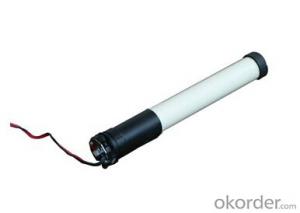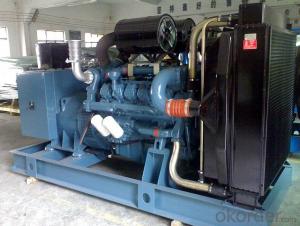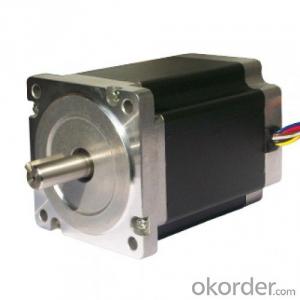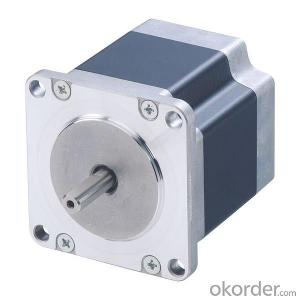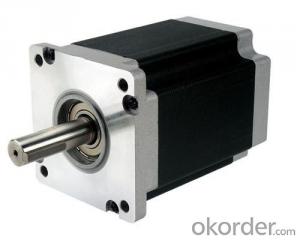Stepper Planetary Gear Motor (H281-1) 28mm
- Loading Port:
- Shanghai
- Payment Terms:
- TT OR LC
- Min Order Qty:
- 1 pc
- Supply Capability:
- 2500 pc/month
OKorder Service Pledge
Quality Product, Order Online Tracking, Timely Delivery
OKorder Financial Service
Credit Rating, Credit Services, Credit Purchasing
You Might Also Like
Stepper Planetary Gear Motor (H281-1) 28mm
Product Details
Basic Info.
Model NO.:H281-1
Application:Monitor
Speed:Low Speed
Number of Stator:Two-Phase
Excitation Mode:HB-Hybrid
Function:Stepper Motor
Number of Poles:4
Type:Hybrid Stepper Motor
Certification:CE Rosh
Brand:I.CH
Size:28mm
Step Angle:1.8
Gearbox:Has One Gearbox
Export Markets:Global
Additional Info.
Trademark:I. CH
Packing:Carton
Standard:CE ROSH
Origin:China
HS Code:85011099
Production Capacity:50000/Month
Product Description
Hybrid Stepper Planetary Gear Motor
HP281-1 28MM
| Motor Electrical Specification | |||||||||
| Series Model | Step Angle ( o ) | L (mm) | Rated Current (A) | Phase Resistance (Ω) | Phase Inductance (mH) | Holding Torque (N.cm) | Detent Torque (N.cm) | Lead Wire (NO.) | Motor Weight ( g) |
| HP281-00506 | 1.8 | 28 | 0.6 | 4.2 | 2.2 | 4.5 | 0.3 | 4 | 105 |
| HP281-00606 | 1.8 | 33 | 0.6 | 5.5 | 3.2 | 6.0 | 0.4 | 4 | 110 |
| HP281-00806 | 1.8 | 41 | 0.6 | 7.0 | 6.0 | 8.0 | 0.5 | 4 | 140 |
| Other Motor Electrical Specification please refer to Hybrid Stepper Motor web | |||||||||
| Gearbox Specification | ||||||||||||
| Ratio | 3.71 | 5.18 | 14 | 19 | 27 | 51 | 71 | 100 | 139 | 189 | 264 | 369 |
| Reducer Series | 1 | 2 | 3 | 4 | ||||||||
| Length ( mm) | 31.0 | 40.1 | 49.0 | 57.9 | ||||||||
| Allowable Torque (Kg.cm) | 12 | 20 | 32 | 40 | ||||||||
| Instantaneous Torque (Kg.cm) | 36 | 60 | 96 | 120 | ||||||||
| Efficiency (%) | 90% | 81% | 73% | 66% | ||||||||
| Weight (g) | 60 | 85 | 95 | 110 | ||||||||
| We can manufacture products according to customer's requirements | ||||||||||||


- Q: What is the meaning of step 1, 1204, 1605,1610?
- What you're talking about is not the type of the step motor, but the type of the screw. For example, 16 is the diameter of the screw in 1605, 16mm. 05 is the lead, which is the distance of the screw to move the weight around 5mm. This means that the 16mm diameter screw will drive the load along the 5mm
- Q: Where does the step motor need
- Many occasions are used, such as office automation (printer, copier, scanner, etc.), thread cutting workbench drag, flocking machine workbench (pores), packaging machine (length). There are also ATM machines, drawing machines, engraving machines, photo-realistic machines, spraying equipment, medical instruments precision instruments, industrial control systems, robots and so on. It is especially suitable for the application of stable, low noise, fast response, long service life and high output torque.
- Q: What is the difference between a step motor drive and a controller
- The drive and the controller are different The function of the actuator is to convert the pulse signal from the controller to the angular displacement and then send it to the step motor The controller is dedicated to send pulse signals to actuators. The PLC, single chip, control card and so on are all controllers Motor is connected to the drive, and drive connected to the controller, only the motors, drives, controller can constitute a complete system, of course, some don't need to drive controller can simulate pulse, but the high cost and less applicable industries
- Q: What is HB step motor
- Hybrid step motor Hybrid stepping is a mixture of permanent magnet and the advantages of reactive, divided into two and five phase, two phase stepper Angle of 1.8 degrees commonly and five phase stepping Angle generally 0.72 degrees, the application of the stepper motor is more widely.
- Q: How do you adjust your step to 90 degrees?
- Steps to move the motor to 90 degrees: By writing the program, the number and frequency of the control pulse of the step motor is adjusted to realize the 90 degree of the moving position of the step motor.
- Q: How does PLC drive the step motor
- Is receiving stepping stepper motor drives to come to the pulse signal, such as two phase stepper, AB output positive and negative pulse phase respectively take turns (in a certain order), step motor can run, the equivalent of a corresponding pulse stepper motor rotation Angle. And PLC can also be a pulse, the pulse voltage is not enough, so you need to give stepper drives the PLC output pulse amplifier to drive the stepper drive, pulse equivalent of PLC pulse is instruction
- Q: What is the difference between direct drive motor, linear motor, servo motor and step motor?
- Servo motor (servo motor) is the engine that controls the operation of mechanical components in servo systems. The servo motor can control the speed, the position accuracy is very accurate, can convert voltage signal to torque and speed to drive control object, closed loop control. Step induction motor: the step motor is to convert the electrical pulse signal into the angular displacement or the line displacement of the open loop control the step into the motor, the pulse open loop control.
- Q: What is the tooth spacing Angle in the step motor? What does it have to do with the step Angle?
- According to the two phases of the broken mountain club SS1404A20A, the stator teeth are 48, the rotor is divided into four sections, the upper blue is 50 teeth, the lower end blue is wrong with the upper end, and it is also 50 teeth. Top yellow 50 teeth, lower end yellow and upper end, also 50 teeth. According to known data, the rotor tooth is 7.2 degrees and the stator is 7.5 degrees.
- Q: What is the characteristic of step motor? Compared with dc motors, what advantages does it have?
- No coder and other feedback devices can be used to control the speed and Angle (i.e. open loop control), which is the most characteristic of stepping motor. The frequency of the pulse determines the speed of the motor, and the number of pulses determines the Angle of the motor. The dc servo system is the following advantages: 1, the locking position, motor power consumption: no longer stepping motor characteristic of the "static torque" (also called "holding torque", "localization" torque, etc.), when the motor stopped in a certain position, locking torque. The dc motor can also lock the position through the drive, but the motor still consumes power when locked.
- Q: The computer embroidery machine step into the motor abnormality
- You that should be a five phase stepping drive, I can tell you is very responsible, stepper drives over-current, when properly you see stepping drive at the back of the lamp should be red, shutdown, stop for a while and can do, so often repeated. The solution Open the inside of the drive, and blow with the electric fan. Of course, replace the small fan inside, and it's even better to blow it with an external fan. The other is to adjust the small current, which can be stitched up so that you can walk.
Send your message to us
Stepper Planetary Gear Motor (H281-1) 28mm
- Loading Port:
- Shanghai
- Payment Terms:
- TT OR LC
- Min Order Qty:
- 1 pc
- Supply Capability:
- 2500 pc/month
OKorder Service Pledge
Quality Product, Order Online Tracking, Timely Delivery
OKorder Financial Service
Credit Rating, Credit Services, Credit Purchasing
Similar products
Hot products
Hot Searches





